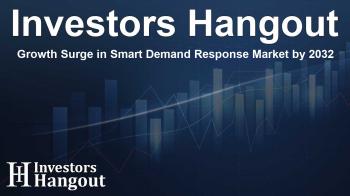Growth Surge in Smart Demand Response Market by 2032

Unleashing the Potential of Smart Demand Response
The landscape of energy management is undergoing a remarkable transformation, primarily driven by the advancement of smart demand response technologies. These solutions hold the promise to not only optimize energy consumption but also play a pivotal role in the integration of renewable energy sources into the global grid. As the world strives for cleaner energy, the smart demand response market has emerged as a beacon of hope.
Market Overview and Key Insights
As per recent research, the Smart Demand Response Market was valued at approximately USD 28.80 billion in 2023, with projections indicating a growth trajectory towards USD 123.66 billion by 2032. This impressive growth, achieving a compound annual growth rate (CAGR) of 17.59% from 2024 to 2032, highlights the increasing reliance on demand response strategies to enhance grid stability and efficiency.
Drivers of Growth
The proliferation of smart technologies like IoT, artificial intelligence (AI), and cloud computing is profoundly impacting traditional demand response systems. In the United States, a reported 94% of companies have already integrated cloud solutions into their operations, facilitating real-time data collection and enhancing decision-making capabilities. Additionally, supportive government initiatives, such as tax benefits and funding for clean energy projects, are accelerating this market's expansion.
Advancing Integration of Renewable Energy
Transitioning toward renewable energy sources is a monumental trend necessitated by climate change and resource scarcity. Smart demand response solutions are essential in managing renewable energy effectively, aligning energy supply and demand. For instance, during peak demand periods, utilities can rely on these systems to adjust energy usage proactively, reducing the burden on the grid and optimizing resource allocation.
Applications Across Sectors
The smart demand response market is characterized by diverse applications across various sectors. The residential sector currently leads the market, accounting for over 55% of total shares due to the growing adoption of smart home technologies. Devices such as smart thermostats and energy management systems empower homeowners to monitor and optimize their energy consumption, making sustainable practices more accessible.
Expanding Markets and Regional Insights
North America is currently the largest region for smart demand response, holding a significant market share fueled by advanced energy infrastructure and a commitment to energy efficiency. Companies like Honeywell and Schneider Electric are at the forefront, offering solutions that support utilities in optimizing their energy resources. Meanwhile, the Asia Pacific region is set for explosive growth, driven by urban expansion and government backing for energy-efficient technologies.
Industrial Sector Focus
The industrial sector is on a promising growth trajectory, anticipated to surpass traditional segments as businesses seek efficiencies amid soaring energy costs. Players like Siemens and Schneider Electric are leading the way with their innovative solutions that allow for dynamic energy adjustments, significantly reducing operational costs and enhancing compliance with energy regulations.
Recent Developments Shaping the Market
Innovations are vital for the smart demand response market's evolution. Recently, Siemens launched the Inhab Energy Monitor, designed for residential use, enabling real-time energy monitoring and optimization. This product reflects a broader trend towards integrating digital tools that empower consumers to manage their energy use more effectively.
Oracle, recognized as a leader in the energy management sector, is also making strides with advanced analytics and demand response solutions that cater to both residential and commercial clients. These developments reinforce the importance of flexibility and innovation in meeting contemporary energy needs.
Frequently Asked Questions
What is the projected growth of the Smart Demand Response Market?
The market is expected to grow from USD 28.80 billion in 2023 to USD 123.66 billion by 2032, reaching a CAGR of 17.59%.
Which sectors are driving this growth?
The residential sector leads the market, while the industrial sector is the fastest-growing due to high energy consumption and efficiency demands.
How does smart demand response contribute to grid stability?
It adjusts electricity usage based on real-time grid signals, which helps manage demand and enhances overall grid stability.
What role do government policies play?
Government initiatives and tax benefits are crucial in promoting the adoption of demand response programs and energy efficiency measures.
Which companies are leading the smart demand response market?
Key players include Siemens, Honeywell, Schneider Electric, and Oracle, all of which offer advanced demand response solutions.
About Investors Hangout
Investors Hangout is a leading online stock forum for financial discussion and learning, offering a wide range of free tools and resources. It draws in traders of all levels, who exchange market knowledge, investigate trading tactics, and keep an eye on industry developments in real time. Featuring financial articles, stock message boards, quotes, charts, company profiles, and live news updates. Through cooperative learning and a wealth of informational resources, it helps users from novices creating their first portfolios to experts honing their techniques. Join Investors Hangout today: https://investorshangout.com/
Disclaimer: The content of this article is solely for general informational purposes only; it does not represent legal, financial, or investment advice. Investors Hangout does not offer financial advice; the author is not a licensed financial advisor. Consult a qualified advisor before making any financial or investment decisions based on this article. The author's interpretation of publicly available data presented here; as a result, they should not be taken as advice to purchase, sell, or hold any securities mentioned or any other investments. If any of the material offered here is inaccurate, please contact us for corrections.
